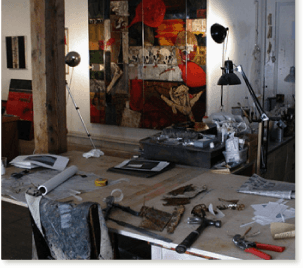MATERIALS & APPROACHES
Paiement has never restricted himself to a "style". In a talk given at the University of New Hampshire in 2010, he gave this description of his early art beginnings: " When art found me, at the ripe old age of 25, I was raging to go. I enrolled in the local college and took a Drawing I class followed up by Drawing II. The Drawing I class was taught by an elderly German gentleman who stacked wooden solids (cubes, rectangular blocks, spheres, pyramids, etc) with very controlled lighting. We were given pencils ranging from 6B to 8H and spent 20 hours on the first drawing trying to get the subtleties of the shading. Drawing II was taught by a Japanese fellow named Suzuki. Our tools consisted of a large 22"X 30" piece of high quality rag paper, a bottle of India ink and a large brush. We were told to 'make some marks!'. After a few minutes of wondering what was going on here, he'd come by and say, 'That's great! Keep it up!'. Being exposed to those two diametrically opposed approaches to art has stayed with me to this day. There are no limits to the variations of putting a mark on a piece of paper or canvas. It has given me great freedom."
"In 2006, inspired by a cache of old ceiling panels scavenged from the building adjacent to his studio in Bath, artist Tom Paiement began a series of large- scale collages that would consume 18 monthes of his life. Collectively called Entropy, the three works that resulted from this intensive period of creativity are monumental in scale, sweeping in content, and stunningly constructed." Maine Home and Design, January / February 2010
Paiement's approach to this abstract period reflected his work with the copper plate. There is much scraping back of the surface, the use of gouging tools and sandpaper and any other tool within reach to take him deeper into the surface. The image to the right shows Paiement at work on two large panels that were used as a table top, a commission from Glenn Close and David Shaw. This was a collaborative effort with woodworker Jamie Johnston.
The materials Paiement used in the Fret Series reflected those used in the building of a guitar: metals, wire rods and pieces of wood. As the series progressed (he spent two years on this project), the paintings became less a representation of a certain mode / scale of guitar notes and more a metaphor for the notes. The latter pieces in the series reflect back to his past abstract period. The introduction of embedded L.E.D. lights in his large (6' X 6') piece, "Fret Series #48", was an idea further explored in his work.
Discovering large, weathered tin ceiling panels in the back of his studio, Paiement was inspired to begin his Entropy paintings; a series that took two years to complete. Working larger than he normally works (the pieces are over 6' tall by 7' across), allowed him a greater freedom in the use of found materials and collage. The political nature of the subject matter was also new to Paiement and pushed him into addressing some of the profound issues of the day.
Paiement was profoundly affected when his son turned 18 and registered for the draft. He decided to delve further into the theme of war and sacrifice, especially the sacrifice of the young, with a focus on their bravery and their sometimes naive attitude towards war. He used metals, steel mesh, iron rod, paper collage and wood to convey the sense of power and hardness that is the military. Chunks of metal were used for helmets and for the symbol of shells flying through the air. The strong graphic line of woodcuts and lino cuts complimented the subject matter as well.
Throughout the years as Paiement has worked on the Flower Series and his methods and materials have varied extensively. The early paintings used materials from his Soldier Series, the metals, wood, wire rod and paper collage. The paintings are raw and powerful, still echoing the political issues of "Entropy" and the tributes made in the Soldier Series. As the paintings move further away from "Entropy's" influence, Paiement incorporates lino and woodcuts into them. The latest flower pieces are a fine balance between color, materials and structure heading ever more into an abstract direction.
Paiement used simple tools, oil pastels and ebony pencil, for the Venice Beach drawings to quickly capture the movement and visual data that surrounded him. Paiement finds drawing from life invigorating, always trying to find the balance between the impulsive mark and the accurately placed mark. He is at work on a series of paintings inspired from the drawings. He states that he is "just beginning to scratch the surface of the possibilities with Venice Beach".






